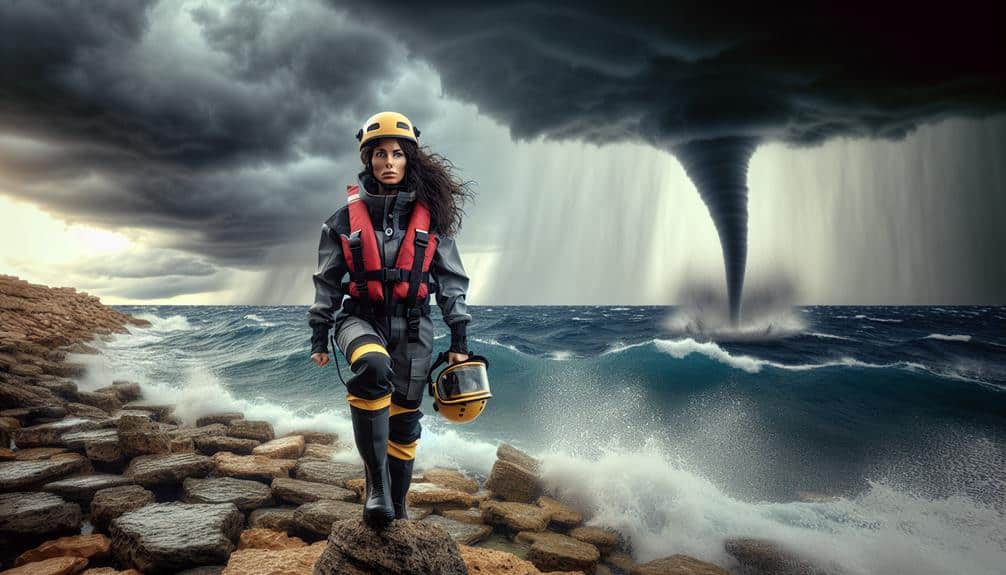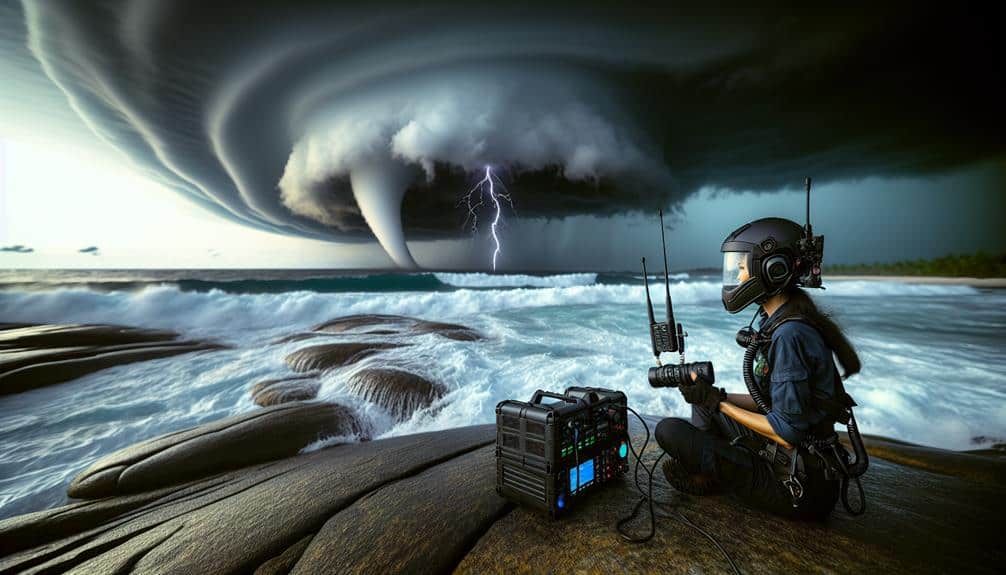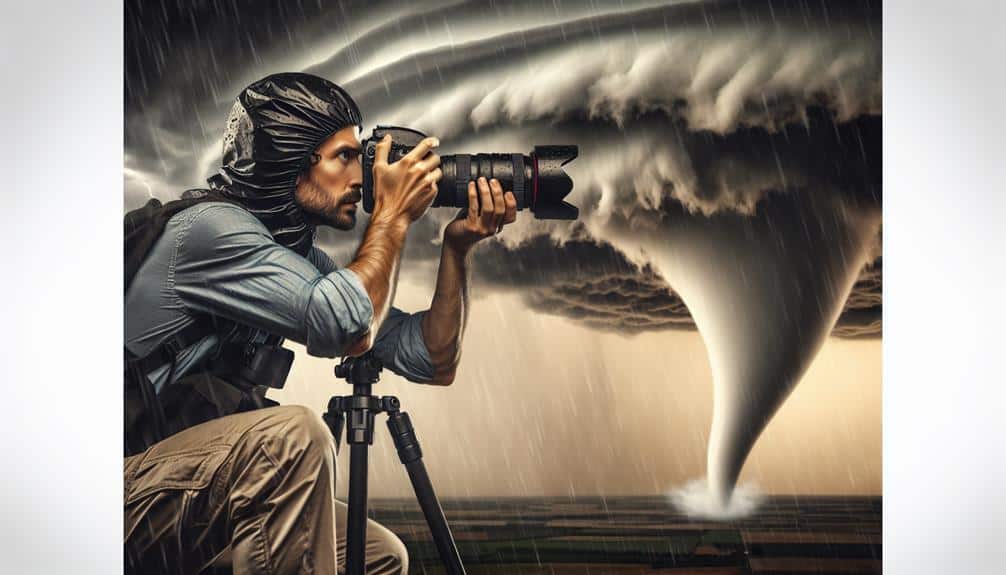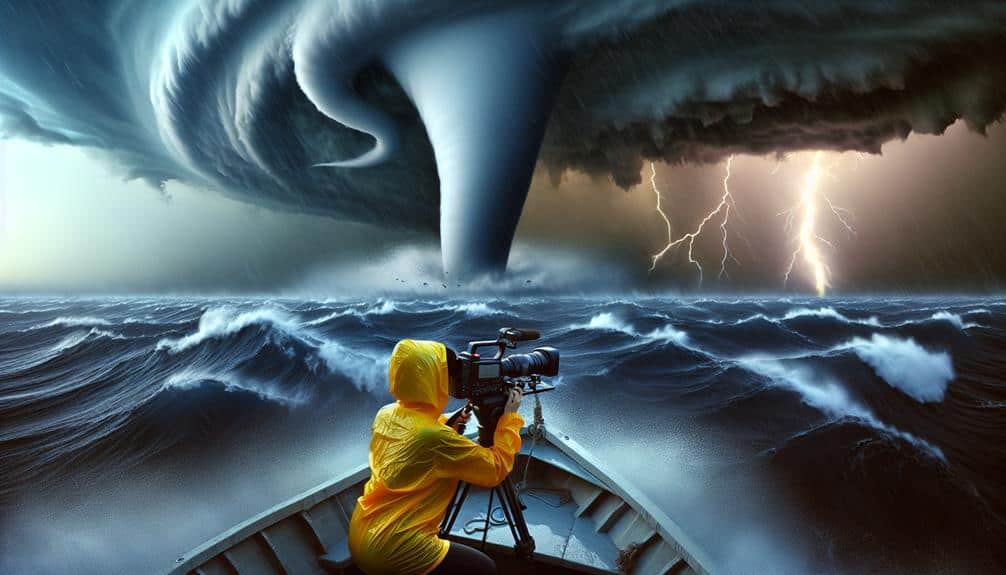As storm chasers, we should begin by grasping waterspout formation and depending heavily on weather forecasts to pinpoint potential zones. Equipping the appropriate protective gear and maintaining a safe half-mile distance is crucial for reducing injury risk by up to 60%. Reliable communication devices and multi-frequency radios guarantee connectivity and rapid emergency response. Adhering to maritime laws and standardized communication protocols minimizes risks at sea. Documenting with gyroscopic stabilizers and precise meteorological data logging preserves research integrity and safety. For thorough guidelines and deeper insight into these strategies, continue exploring effective storm chasing practices.
Key Points
- Maintain a safe half-mile distance from waterspouts using GPS and radar systems for accurate monitoring.
- Utilize high-definition weather models and real-time data from reliable sources like NWS for timely updates.
- Wear protective clothing, waterproof gear, and helmets to reduce injury risk and maintain mobility.
- Follow strict communication protocols with multi-frequency radios and GPS tracking for efficient coordination and rescue.
Understand Waterspout Formation
To effectively chase waterspouts, we need to grasp the key meteorological conditions that foster their formation. First, let's examine water temperature. Warm water, typically above 26°C (79°F), provides the necessary heat and moisture to fuel waterspout development. This thermal energy promotes the rapid evaporation and condensation cycles critical for cloud formation.
Next, we need to analyze wind conditions. Converging winds at the surface can create a localized area of low pressure, essential for waterspout genesis. These converging winds often result from differing air masses meeting, producing a horizontal rotation that can be tilted vertically by updrafts.
Air pressure plays a pivotal role as well. A sharp drop in pressure can destabilize the lower atmosphere, aiding in the formation of towering cumulus clouds. These clouds, characterized by their vertical development, are often the precursors to waterspouts.
Check Weather Forecasts
When chasing waterspouts, we must prioritize checking weather forecasts from reliable sources to enhance our accuracy.
By analyzing weather patterns, we can identify potential formation zones and best conditions.
Additionally, real-time updates allow us to adjust our strategies dynamically, ensuring safety and effectiveness.
Reliable Forecast Sources
Before embarking on any storm-chasing expedition, we must rely on high-definition weather models and real-time data from trusted meteorological sources to accurately predict the formation and path of waterspouts. Our first step is to utilize advanced storm tracking tools and weather apps that offer precise, up-to-the-minute information. These resources allow us to identify potential waterspout formations and their likely trajectories, giving us a tactical advantage.
Accessing meteorological data from reliable sources, such as the National Weather Service (NWS) or the European Centre for Medium-Range Weather Forecasts (ECMWF), is pivotal. These organizations use sophisticated radar technology to provide detailed insights into atmospheric conditions, including wind patterns, temperature gradients, and humidity levels. By analyzing this data, we can make informed decisions about when and where to position ourselves for the best chance of encountering a waterspout while maintaining safety.
Our dedication to using high-quality weather apps and storm tracking systems ensures that we stay ahead of rapidly changing weather conditions. Leveraging these tools gives us the freedom to chase storms with confidence, knowing we've the most accurate and timely information at our fingertips.
Weather Patterns Analysis
Examining weather patterns involves inspecting atmospheric data to identify key indicators that precede waterspout formation, such as wind shear, temperature differences, and humidity levels. To effectively engage in storm tracking, we need to explore detailed weather patterns that highlight these essential elements. By examining synoptic charts and utilizing advanced meteorological tools, we can pinpoint areas where atmospheric conditions are favorable for waterspout development.
We start by looking at wind shear, evaluating both directional and speed shear in the lower atmosphere. Variations in wind direction and velocity can contribute to the rotational dynamics necessary for waterspouts. Temperature differences, especially between the water surface and the air above, create the thermodynamic instability that fuels these phenomena. High humidity levels enhance this process by providing the moisture needed for cloud formation and subsequent waterspouts.
In storm prediction, understanding mesoscale and microscale weather patterns is important. We analyze satellite imagery and Doppler radar data to observe convective activities and identify potential hotspots. Software models, such as WRF (Weather Research and Forecasting), help simulate atmospheric conditions, enabling us to forecast waterspout occurrences with greater precision.
Mastering these tools and methods allows us to chase waterspouts confidently and safely, ensuring we harness the freedom that comes with informed storm chasing.
Real-time Updates
To maximize our chances of successfully chasing waterspouts, we rely on real-time updates from advanced weather forecasting systems that provide the latest atmospheric data and predictive models. These tools are essential for storm tracking and help us make informed decisions while in the field. By leveraging live streaming capabilities, we can continuously monitor weather updates and adapt our strategy on the fly.
Interactive maps are particularly valuable as they allow us to visualize storm patterns and potential waterspout formations. These maps offer layers of data, including wind speed, humidity, and temperature gradients, vital for understanding the evolving dynamics of the storm. We often use these maps in tandem with live radar feeds to pinpoint high-risk areas.
Equipped with mobile devices and specialized apps, we can receive push notifications on our location, ensuring we stay ahead of sudden weather changes. This real-time intelligence not only enhances our safety but also increases the likelihood of capturing compelling footage.
In essence, our ability to chase waterspouts effectively hinges on integrating these sophisticated tools. By maintaining a constant flow of accurate data, we empower ourselves to navigate the unpredictable nature of storm chasing with greater precision and confidence.
Equip Proper Safety Gear

When equipping proper safety gear, we must prioritize essential protective clothing, emergency communication devices, and high-visibility markings.
Data shows that appropriate protective clothing can reduce injury risk by up to 60%.
High-visibility markings and reliable communication devices guarantee we stay visible and connected in hazardous conditions.
Essential Protective Clothing
Proper safety gear, including high-quality helmets, waterproof suits, and puncture-resistant boots, is vital for minimizing risks while chasing waterspouts. When we're out there, the right protective clothing can mean the difference between a thrilling adventure and a hazardous situation.
Waterproof Gear:
Staying dry isn't just about comfort; it's about safety. Waterproof suits protect us from hypothermia and other cold-related issues. High-quality waterproof gear ensures that we maintain our mobility and functionality in adverse weather conditions.
Protective Eyewear:
Visibility is essential. Protective eyewear shields our eyes from debris and intense wind, allowing us to maintain clear vision. The eyewear should meet ANSI Z87.1 standards to guarantee maximum protection against high-velocity impacts.
High-Quality Helmets:
A helmet protects our heads from falling debris and other impacts. Helmets certified by ASTM or CE standards offer the best protection. They should fit snugly without compromising comfort, ensuring that we can focus on the task at hand.
Puncture-Resistant Boots:
Our feet need to be safeguarded from sharp objects and slippery surfaces. Boots with ASTM F2413-18 certification provide puncture resistance and slip protection, allowing us to navigate treacherous terrain confidently.
Emergency Communication Devices
Equipping ourselves with reliable emergency communication devices guarantees we can maintain contact with our team and emergency services, even in the most challenging conditions. Satellite phones are indispensable when chasing waterspouts in remote areas where cellular networks fail. They offer robust connectivity, ensuring seamless communication.
We also carry emergency beacons, which are critical for transmitting distress signals. These devices can alert rescue teams within minutes, notably reducing response times.
Implementing strict communication protocols is essential. By standardizing check-ins and emergency alerts, we minimize miscommunication and guarantee real-time updates. This systematic approach enhances our ability to make informed decisions quickly.
Additionally, integrating GPS tracking into our communication devices provides precise location data, which is crucial for both navigation and emergency response.
Data shows that the use of satellite phones and emergency beacons reduces the average rescue time by up to 40%. This is particularly crucial in high-risk scenarios where every second counts. Our commitment to utilizing state-of-the-art technology not only enhances our operational efficiency but also safeguards our freedom to explore extreme weather phenomena with confidence.
We're not just chasing waterspouts; we're pushing the boundaries of what's achievable, safely and effectively.
High-Visibility Markings
Securing our safety during waterspout chases necessitates the use of high-contrast markings on all gear and vehicles, reducing the risk of accidents in low-visibility conditions. Integrating fluorescent gear and visibility markers into our equipment arsenal is crucial. When storm clouds obscure natural light, vivid colors act as vital visual cues, making us easily identifiable to fellow chasers and emergency personnel.
To maximize our safety precautions, consider the following essential items:
- Fluorescent Vests and Jackets: These garments, equipped with reflective strips, greatly enhance visibility, even in the most challenging weather conditions.
- Vibrantly Colored Vehicle Decals: Applying high-contrast markers to our vehicles ensures they stand out, decreasing the likelihood of collisions in poor visibility.
- Reflective Tape: Strategically placing reflective tape on gear and equipment enhances their visibility, ensuring they're easily spotted if misplaced or needed urgently.
- LED Flare Kits: Equipping vehicles with LED flares provides a strong, highly visible warning system during night chases or dense fog scenarios.
Maintain Safe Distance
We must consistently uphold a safe distance of at least half a mile from waterspouts to minimize the risk of sudden changes in their path. This safety measure is crucial as waterspouts can shift rapidly, posing unforeseen hazards.
Our primary objective is to guarantee our freedom to document these phenomena without compromising our safety. To achieve this, we must equip ourselves with proper gear, including GPS devices and anemometers, to monitor our proximity to the waterspout accurately. Distance awareness is critical; relying solely on visual estimation can lead to misjudgments.
Advanced radar systems can provide real-time data, facilitating dynamic risk assessment and helping us make informed decisions. Moreover, maintaining this half-mile buffer allows us to respond effectively to unexpected intensifications or directional changes.
An in-depth risk assessment should include analyzing the waterspout's rotational velocity and potential debris field. By doing so, we can anticipate its behavior and adjust our position accordingly.
In essence, our commitment to upholding a safe distance not only safeguards us but also enhances our ability to capture high-quality data and footage. Adhering to these guidelines ensures that our pursuit of freedom and adventure remains grounded in safety and precision.
Use Reliable Communication

In order to maintain situational awareness during storm chasing operations, leveraging dependable communication systems is crucial. Our ability to respond promptly and accurately to evolving weather conditions hinges on robust communication protocols and clear channels with emergency contacts.
We need to ensure our devices maintain peak signal strength and GPS accuracy. Precision in our location data not only enhances our safety but also contributes to the effectiveness of our pursuit. To achieve this, we've got to follow these critical steps:
- Equip with Multi-frequency Radios: Using multi-frequency radios guarantees we can communicate even when cellular networks fail. These radios provide redundancy, a crucial factor during high-stakes chase scenarios.
- Regularly Update Emergency Contacts: Keep a regularly updated list of emergency contacts, including local maritime authorities. This guarantees that help is reachable when seconds count.
- Invest in High-Efficiency Antennas: High-efficiency antennas boost signal strength, significantly improving our ability to maintain communication in remote or storm-affected areas.
- Utilize GPS Tracking Software: Employing advanced GPS tracking software ensures pinpoint accuracy, allowing us to share our precise location with our team and emergency services.
Respect Maritime Laws
Adhering to maritime laws is crucial for the safety of our storm chasing operations and the protection of other vessels in the vicinity. By strictly following safety protocols and navigation rules, we make sure our activities don't endanger ourselves or others. Mariners' laws, like the International Regulations for Preventing Collisions at Sea (COLREGs), provide a framework for safe navigation, including right-of-way conventions and signal usage. We must integrate these guidelines into our storm chasing strategies to operate responsibly.
Understanding and practicing vessel etiquette is another critical aspect. It's important to maintain proper communication with nearby boats, using radio frequencies designated for maritime communication. Implementing navigation lights and sound signals according to regulations helps us avoid collisions, especially in low-visibility conditions typical of storm environments.
Additionally, we should remain aware of local maritime zones and restricted areas. Entering these zones without authorization can result in hefty fines or legal consequences. For example, many regions have protected marine areas that are off-limits to ensure environmental preservation. As storm chasers, respecting these boundaries showcases our commitment to responsible navigation and environmental stewardship.
Document With Caution

While adhering to maritime laws guarantees our operational safety, documenting waterspouts demands meticulous care to avoid compromising the integrity of our data and the safety of our team. We must use caution at every step to maintain proper documentation. By maintaining a disciplined approach, we not only gather accurate information but also protect ourselves from potential hazards.
Let's talk about some key practices:
- Maintain Distance: Keep a safe distance from the waterspout to avoid being caught in its path. This secures our equipment stays intact and we remain out of harm's way.
- Stabilize Equipment: Use gyroscopic stabilizers and waterproof casings for cameras and other recording devices. This prevents motion blur and water damage, preserving the quality of our documentation.
- Data Logging: Systematically log meteorological data such as wind speed, temperature, and humidity. Accurate and consistent data logging enhances the validity of our research and analysis.
- Team Coordination: Establish a clear communication protocol within the team. Effective coordination minimizes risks and maintains everyone is aware of their roles and responsibilities.
Frequently Asked Questions
Are Waterspouts More Common in Certain Seasons or Months?
Imagine the seasons as a symphony, each with its own tempo. Waterspout frequency rises in warmer climates, peaking in late summer and early fall. Seasonal patterns show waterspouts thrive when temperatures and humidity levels are at their best.
How Do Waterspouts Impact Marine Life and Ecosystems?
Waterspouts can greatly impact marine conservation efforts by causing ecosystem disruption. They alter habitats, affecting species survival rates. Data indicates shifts in population dynamics and biodiversity loss, necessitating targeted strategies for ecosystem resilience and species protection.
Can Drones Be Used Safely to Observe Waterspouts?
We can safely use drones to observe waterspouts by adhering to drone regulations and prioritizing safety. Advanced weather monitoring technology allows precise data collection, enhancing our understanding while minimizing risks associated with traditional storm chasing methods.
What Are the First Signs That a Waterspout Is Forming?
We first notice a waterspout forming when specific weather patterns align. Look for storm clouds with rapid vertical development, shifts in wind direction, and localized changes in water temperature. These indicators suggest a rising vortex may soon appear.
Are There Any Specific Locations Known for Frequent Waterspout Occurrences?
We find the ideal locations for frequent waterspout occurrences in the Florida Keys and the Great Lakes. For top-notch chasing strategies, we should monitor sea breeze convergence zones and use real-time data to track developing weather patterns.


